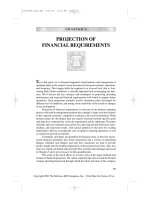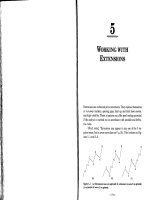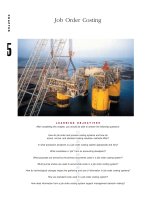Chapter 5 investments risk and return past and prologue
Bạn đang xem bản rút gọn của tài liệu. Xem và tải ngay bản đầy đủ của tài liệu tại đây (546.04 KB, 43 trang )
Chapter 5
Risk and Return:
Past and Prologue
5.1 Rates of Return
5-2
5.1 Rates of Return
Holding-Period Return (HPR)
•
Rate of return over given investment period
HPR= [PS PB + CF] / PB−
•
PS = Sale price, PB = Buy price,
CF = Cash flow during holding period
5.1 Rates of Return
Measuring Investment Returns over Multiple
Periods
•
Arithmetic average
- Sum of returns in each period divided by number of periods
•
Geometric average
- Single per-period return that would gives the same cumulative
performance as the sequence of actual returns
- Compound period-by-period returns; find per-period rate
that compounds to same final value
- Called a time-weighted average return
Table 5.1 Quarterly Cash Flows/Rates of Return of a
Mutual Fund
1st
Quarter
2nd
Quarter
3rd
Quarter
4th
Quarter
Assets under management at start of
quarter ($ million)
1 1.2 2 0.8
Holding-period return (%) 10 25
−20
20
Total assets before net inflows 1.1 1.5 1.6 0.96
Net inflow ($ million) 0.1 0.5
−0.8
0.6
Assets under management at end of
quarter ($ million)
1.2 2 0.8 1.56
5.1 Rates of Return
From Table 5.1
•
Arithmetic average of quarterly return
(10+25-20+20)/4 = 8.75%
•
Geometric average of quarterly return
(1+0.10) X (1+0.25) X (1-0.20) X (1+0.20) = (1+rg)4
rg = 0.0719 or 7.19%
5.1 Rates of Return
Conventions for Annualizing Rates of Return
Returns on assets with regular cash flows usually are quoted as an
nual percentage rates, or APRs.
- Mortgage: Monthly payments
- Bonds: Semiannual coupons
Without compounding:
APR = Per-period rate × Periods per year
With compounding:
1 + EAR = (1 + Rate per period)
n
= (1 + )
n
APR = [(1 + EAR)1/
n
– 1]
X
n
APR
n
Conventions for Annualizing Rates of Return
Example:
Suppose you have a 5% HPR on a 3 month
investment. What is the annual rate of return with
and without compounding?
Without:
With:
n = 12/3 = 4, so HPRann(APR) = HPR*n = 0.05*4 = 20%
HPRann(EAR) = (1.054) - 1 = 21.55%
5-8
Example:
Suppose you buy one share of a stock today for $45 and you hold it for two years and s
ell it for $52. You also received $8 in dividends at the end of the two years.
(PB = , PS = , CF = ):
HPR =
HPRann (APR)=
The annualized HPR assuming annual compounding is (n= ):
HPRann (EAR)=
$45
$52 $8
(52 - 45 + 8) / 45 = 33.33%
0.3333/2 = 16.66%
1/2
(1+0.3333)1/2 - 1 = 15.47%
Annualized w/out compounding
5-9
Conventions for Annualizing Rates of Return
5.2 Risk and Risk Premiums
5-10
Scenario Analysis and Probability Distributions
•
Scenario analysis: Possible economic scenarios;
specify likelihood and HPR
•
Probability distribution: Possible outcomes with
probabilities
•
Expected return: Mean value of distribution of HPR
•
Variance: Expected value of squared deviation from
mean
•
Standard deviation: Square root of variance
Subjective expected returns
E(r) = Expected Return
p(s) = probability of a state
r(s) = return if a state occurs
1 to s states
Measuring Mean:
: The reward from the investment.
E(r) = p(s) r(s)
Σ
s
5-12
SD(r)=σ = [σ2]1/2
E(r) = Expected Return
p(s) = probability of a state
rs = return in state “s”
Measuring Variance or Dispersion of Returns
: The risk to the investment
5-13
∑
−×==
s
2
s
2
E(r)][rp(s)σVar(r)
Numerical Example
State Prob. of State Return
1 .2 - .05
2 .5 .05
3 .3 .15
E(r) =
(.2)(-0.05) + (.5)(0.05) + (.3)(0.15) = 6%
σ2 = [(.2)(-0.05-0.06)2 + (.5)(0.05- 0.06)2 + (.3)(0.15-0.06)2]
σ2 = 0.0049%2
σ = [ 0.0049]1/2 = .07 or 7%
5-14
∑
−×=
s
2
s
2
E(r)][rp(s)σ
Characteristics of Probability Distributions
1. Mean: __________________________________
2. Median: _________________
3. Variance or standard deviation:
4. Skewness:_______________________________
5. Leptokurtosis: ______________________________
If a distribution is approximately normal, the distribution
is fully described by _____________________
Arithmetic average & usually most likely
Dispersion of returns about the mean
Long tailed distribution, either side
Too many observations in the tails
Characteristics 1 and 3
Middle observation
5-15
Normal Distribution
E[r] = 10%
σ
= 20%
Average = Median
Risk is the possibility of
getting returns different
from expected.
σ measures deviations above the
mean as well as below the mean.
With symmetric distribution, it is ok
to use σ to measure risk.
5-16
•
Central to the theory and practice of investment
•
Bell-shaped plot is symmetric
•
The probabilities are highest for outcomes near the mean
Normal Distribution
5-17
Critical Simplifications
1. The return on a portfolio comprising two or more assets
whose returns are normally distributed also will be normally
distributed.
2. The normal distribution is completely described by its mean
and standard deviation.
3. The standard deviation is the appropriate measure of risk for
a portfolio of assets with normally distributed returns.
Risk Premium & Risk Aversion
The risk free rate is the rate of return that can be earned with certainty.
The risk premium is the difference between the expected return of a risky asset and the r
isk-free rate.
Excess Return or Risk Premiumasset = E[rasset] – rf
Risk aversion is an investor’s reluctance to accept risk.
How is the aversion to accept risk overcome?
: By offering investors a higher risk premium.
5-18
The Sharpe(Reward-to-Volatility) Measure
A statistic commonly used to rank portfolios in terms of risk-return trade-off is Sharp
e (or reward-to-volatility) measure
S = Portfolio risk premium / Standard deviation of portfolio excess return
= (
E(rp) – rf
) /
σp
(A risk-free asset: a risk premium=0, a standard deviation=0)
Quantify the incremental reward for each increase of 1% in the standard deviation of
that portfolio.
A higher sharp ratio indicates a better reward per unit of volatility (a more efficient po
rtfolio)
5-19
5.3 The Historical Record
5-20
5-21
Figure 5.4 Rates of Return on Stocks, Bonds, and Bills
5.4 Inflation and Real Rates of Return
5-23
Inflation rate
: The rate at which prices are rising, measured as the rate of increase of
the CPI.
Nominal interest rate
: The interest rate in terms of nominal (not adjusted for purchasing
power) dollars.
Real interest rate
: The excess of the interest rate over the inflation rate.
The growth rate of purchasing power derived from an investment.
Real vs. Nominal Rates
Real rate ≈ Nominal rate - Inflation rate
rreal ≈ rnom - i
Example rnom = 9%, i = 6%
rreal ≈ 3%
Fisher effect: Exact
(1+rreal)*(1+ i) = (1+ rnom)
rreal = or
rreal =
rreal =
The exact real rate is less than the approximate real rate.
[(1 + rnom) / (1 + i)] – 1
(rnom - i) / (1 + i)
(9% - 6%) / (1.06) = 2.83%
rreal = real interest rate
rnom = nominal interest rate
i = expected inflation rate
5-24
Figure 5.5 Interest Rates, Inflation,
and Real Interest Rates 1926-2010









